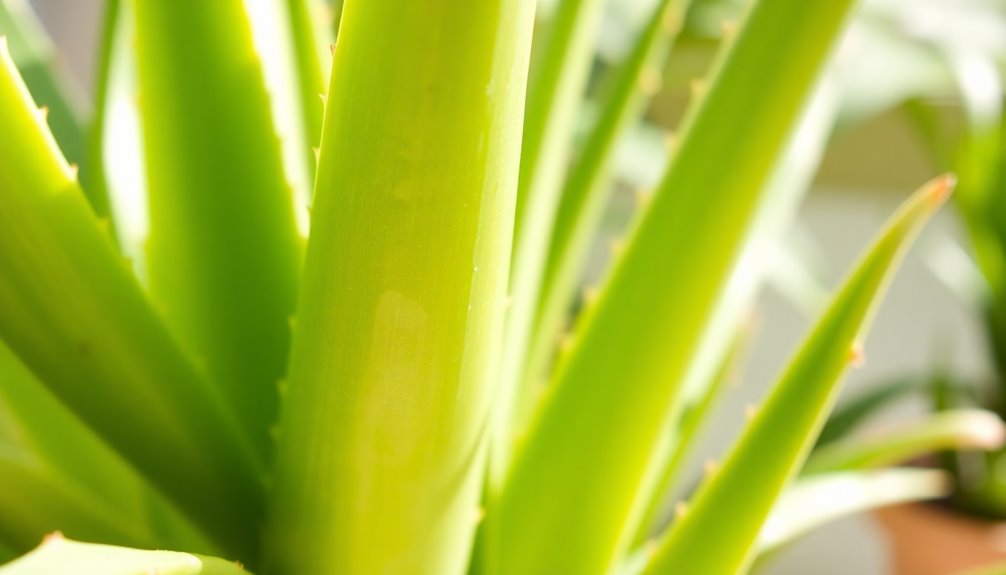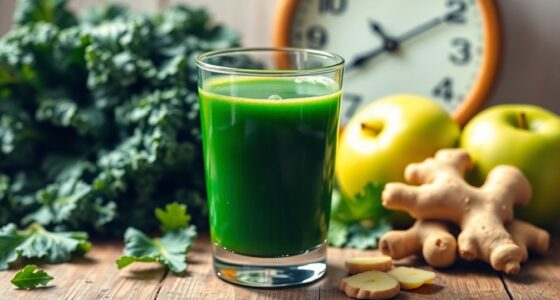Aloe vera plants face several issues like pests, watering problems, and light stress. If you spot brown, squishy leaves, you might be overwatering. On the other hand, dry, wrinkled leaves suggest underwatering. Weak, stretched leaves indicate low light. Regular inspections can help you catch pests like mealybugs or spider mites early. Address these problems promptly for healthier growth. You'll soon discover more tips to keep your aloe thriving!
Key Takeaways
- Inspect for pests like mealybugs and spider mites, which weaken the plant by sucking sap.
- Brown leaves indicate underwatering or low humidity; adjust watering and humidity levels.
- Overwatering causes squishy leaves and root rot; ensure soil dries almost completely between waterings.
- Weak, stretched leaves suggest insufficient light; provide at least 6 hours of bright, indirect sunlight daily.
- Regularly check for signs of stress, such as drooping or discoloration, and adjust care accordingly.
Common Aloe Vera Plant Problems
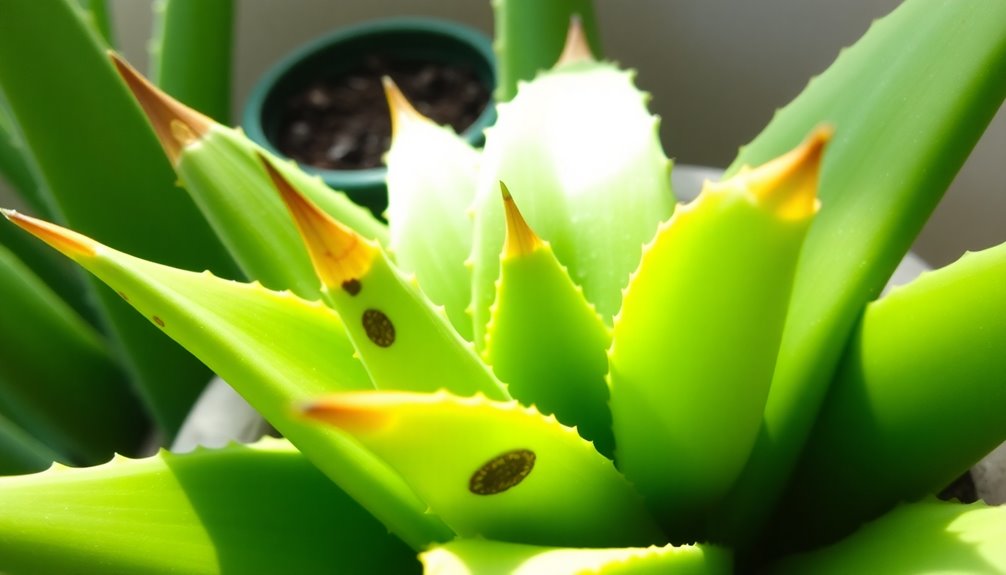
When caring for your aloe vera plant, you might encounter several common problems that can affect its health. One major issue is pests and diseases; mealybugs and spider mites can weaken your plant. Regularly inspect your aloe and treat infestations promptly.
If you notice your aloe's leaves turning brown, it might be a sign of underwatering or low humidity. Adjust your watering frequency to help revive it.
Overwatering is another concern, leading to squishy leaves and root rot, so guarantee the soil dries out completely between waterings.
Also, if you see yellowing leaves, consider that it may be part of the natural aging process or linked to moisture issues, prompting you to double-check your watering habits.
Signs of Stress in Aloe Vera Plants

When your aloe vera plant shows signs of stress, it's essential to identify the cause quickly.
Weak, stretched leaves often mean it's not getting enough light, while leathery leaves can indicate underwatering.
Light-related Leaf Issues
To guarantee your aloe vera thrives, it's crucial to understand how light affects its health. Insufficient light can stretch your plant's leaves, while too much direct sunlight can cause browning.
Here are some signs of light-related leaf issues to watch for:
- Weak, stretched leaves – Your plant is reaching for more light (etiolation).
- Flat or thin leaves – Indicates inadequate light exposure.
- Curled leaves – Often a result of low moisture combined with poor light.
If you notice drooping or discoloration in the leaves, it's time to reassess your plant's placement.
Regularly rotating your aloe during watering can also help guarantee it gets even light exposure, promoting healthier growth. Additionally, providing your aloe plant with proper drainage and avoiding overwatering can significantly enhance its overall health. With adequate care, not only will your aloe thrive, but you can also enjoy its numerous benefits, such as using aloe vera for skin rejuvenation. The soothing properties of aloe make it an excellent natural remedy for hydrating and revitalizing the skin. Moreover, incorporating a balanced fertilizer during the growing season can further contribute to the vitality of your aloe plant, ensuring it has all the essential nutrients it needs. To understand the full spectrum of its advantages, many resources detail the various properties of this versatile plant, with various ‘aloe vera skin benefits explained. ‘ By nurturing your aloe properly, you not only foster its growth but also cultivate a powerful ally for your skincare routine, allowing you to harness its healing potential effectively.
Watering Stress Symptoms
Understanding how to water your aloe vera is essential for its health, as improper watering can lead to significant stress symptoms.
If you notice browning and mushy leaves, your plant is likely suffering from overwatering and possibly root rot. On the other hand, signs of underwatering include wrinkling, curling, and drying leaves, which indicate the plant's struggle to retain moisture.
Droopy leaves may suggest insufficient light but can also point to overwatering or root issues, so check the soil moisture. Brown leaf tips or spots signal underwatering or low humidity, urging you to adjust your watering practices.
Healthy aloe vera leaves should feel firm; squishy ones indicate overwatering, while stiff leaves suggest dryness.
Watering Issues: Overwatering and Underwatering
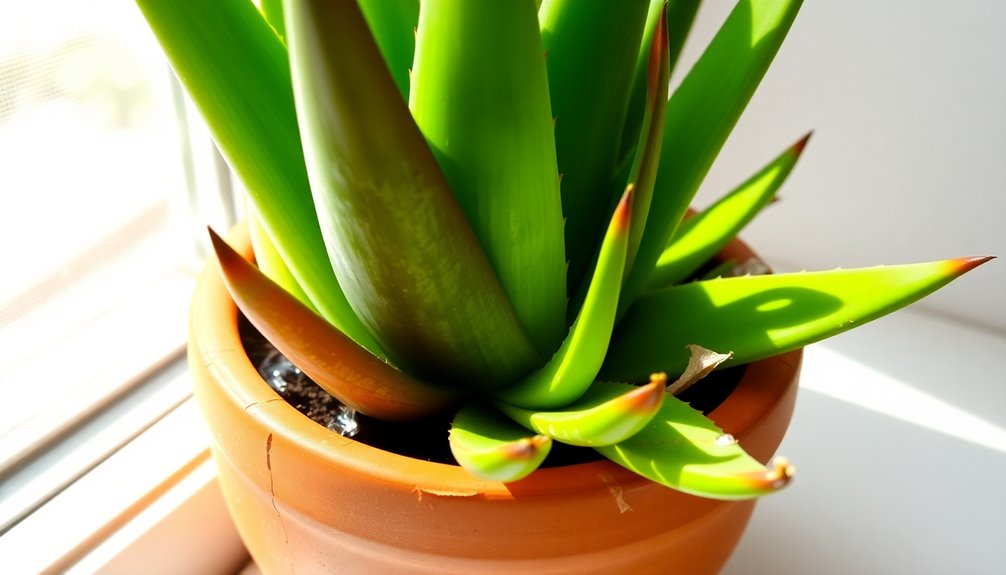
Aloe vera thrives on a delicate balance of moisture, so it's crucial to be mindful of your watering habits. Overwatering can lead to mushy leaves and root rot, while underwatering results in wrinkled, curling leaves.
Here are three signs to watch for:
- Overwatering: Brown, wilting, and soft leaves signal that it's time to stop watering and let the soil dry out completely.
- Underwatering: If you notice your aloe's leaves are wrinkled and dry, it's time for a thorough watering to saturate the soil.
- Soil moisture: Always check soil moisture levels, allowing it to dry almost completely between watering sessions, especially in cooler months when moisture lingers longer.
Balance is key for your aloe's health!
Light and Temperature Effects on Growth
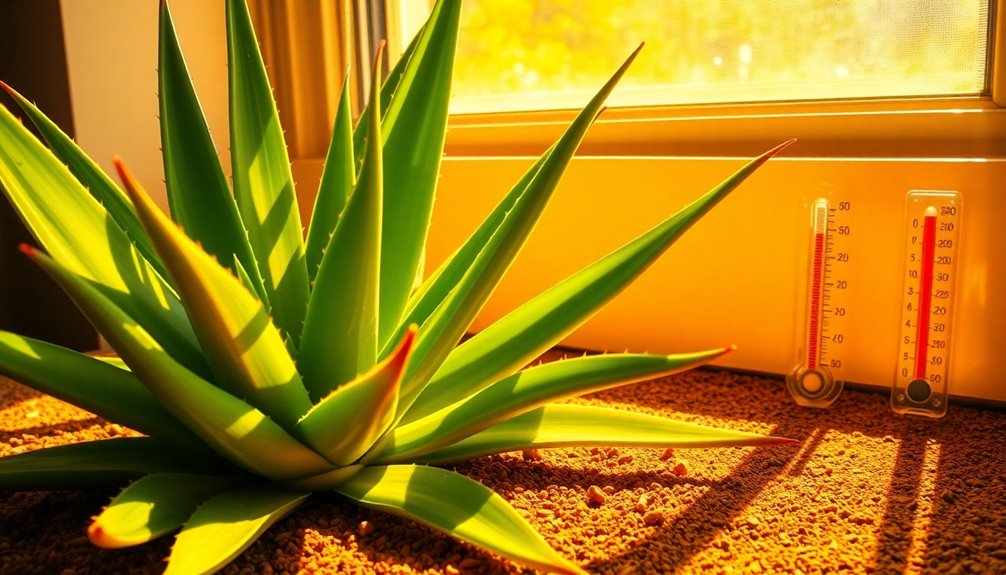
To help your aloe vera thrive, guarantee it gets at least 6 hours of bright, indirect sunlight daily.
Temperature stability is just as important—keep it between 55 and 80°F to avoid stress and damage.
Watch for signs of light stress, like browning or curling leaves, which can indicate it's not getting the right exposure.
Optimal Light Conditions
While many indoor plants can tolerate low light, aloe vera thrives in bright, indirect sunlight, needing at least six hours of light each day for ideal growth.
Without suitable light conditions, your plant can suffer from etiolation, resulting in weak, elongated leaves that can't be fixed.
To guarantee your aloe thrives, consider the following:
- Place it near a west-facing window for the perfect balance of light.
- Rotate the plant regularly during watering for even light exposure.
- Avoid direct sunlight to prevent scorching, particularly from south-facing windows.
Additionally, maintaining the right air quality is crucial for overall plant health, as poor air circulation can affect growth and vitality.
Temperature Stability Importance
Maintaining the right temperature is just as important as providing adequate light for your aloe vera plant. Aloe vera thrives in a temperature range of 55 to 80 degrees Fahrenheit.
Sudden temperature fluctuations can stress your plant, causing drooping leaves or stunted growth. If temperatures dip below 50°F, you may notice browning and soft spots on the leaves, indicating cold damage.
Conversely, if temperatures exceed 90°F, your plant might experience leaf curling and dehydration. To keep your aloe healthy, regularly monitor temperature changes, especially during seasonal shifts.
Ensuring a stable environment will help prevent temperature-related stress and promote ideal growth for your aloe vera plant.
Signs of Light Stress
Have you noticed your aloe vera plant showing signs of distress? If you see drooping leaves or stretched leaves, it's likely a sign of light stress.
Aloe vera plants thrive in bright, indirect light, and inadequate exposure can lead to these issues. Here are a few signs to watch for:
- Drooping leaves: A clear indication of insufficient light.
- Stretched leaves: This happens when your plant reaches for more light and won't revert back.
- Browning or curling: This indicates too much direct sunlight, which can scorch the leaves.
To keep your aloe healthy, place it near a west-facing window and rotate it during watering.
Regularly check light conditions to guarantee your plant gets the brightness it needs!
Pest Infestations and Their Impact

Aloe Vera plants can face serious challenges from pest infestations, which, if not addressed quickly, can lead to significant damage. Among the most common pests are mealybugs, scale insects, and spider mites. Mealybugs show up as cotton-like clusters, while spider mites create fine webbing and mottled leaves. Here's a quick overview of these pests:
| Pest Type | Impact on Aloe Vera |
|---|---|
| Mealybugs | Suck sap, causing weakness |
| Scale Insects | Dark bumps that weaken the plant |
| Spider Mites | Fine webbing and stippled leaves |
| Aphids | Leaf curling and potential mold growth |
| Overall Damage | Reduced liveliness and potential plant death |
Regular inspections and immediate treatment are essential to maintaining your plant's health.
Solutions for Common Aloe Vera Plant Issues
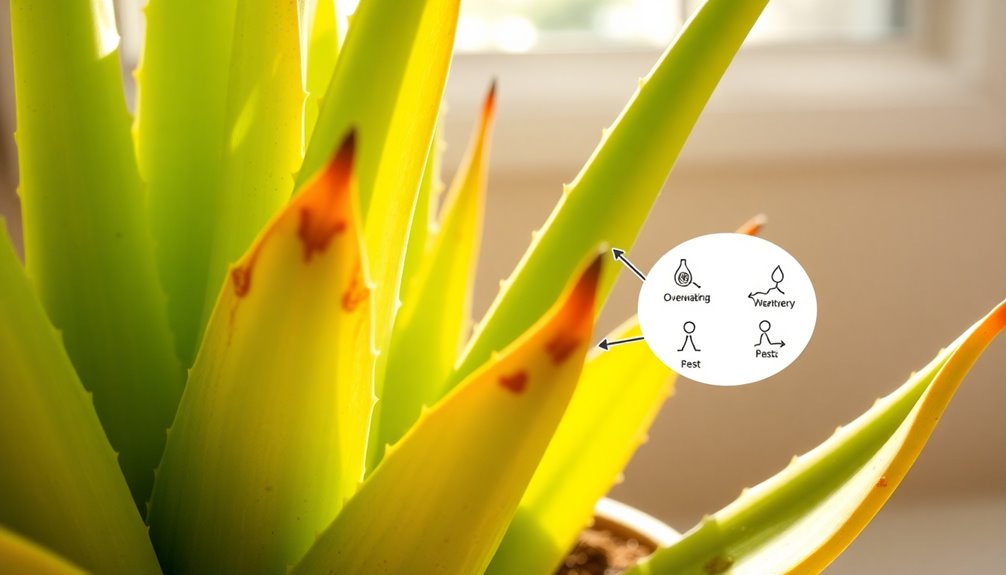
When dealing with common issues in your Aloe Vera plant, identifying the problem early can make all the difference in restoring its health. Here are some solutions to tackle those pesky problems:
1. Overwatering: If you notice mushy, brown leaves, allow the soil to dry out completely before watering again.
Prune any damaged roots to promote recovery.
2. Yellowing Leaves: Check the soil moisture; yellowing can indicate overwatering or nutrient deficiencies.
Adjust your watering habits, as Aloe is more forgiving of underwatering.
3. Pest Infestations: Regularly inspect for mealybugs or spider mites.
If you spot them, apply insecticidal soap or neem oil to affected areas to prevent further damage.
With these steps, your Aloe Vera can bounce back to health!
Frequently Asked Questions
How to Treat Aloe Vera Leaf Spot Disease?
To treat aloe vera leaf spot disease, start by inspecting your plant for dark, water-soaked spots.
Apply a suitable fungicide directly to the affected areas, following the instructions on the label.
Don't forget to remove and dispose of any severely affected leaves to stop the spread.
Confirm your plant has good air circulation and avoid overhead watering to keep the leaves dry.
Regular checks will help maintain your plant's overall health.
How Do I Know What's Wrong With My Aloe Plant?
Did you know that nearly 50% of plant owners struggle with identifying issues in their greenery?
To know what's wrong with your aloe plant, start by inspecting the leaves for discoloration, like browning or yellowing.
Check the soil moisture; aloe prefers to dry out.
Look for droopy leaves, which might indicate insufficient light.
Finally, monitor for pests by checking the undersides of leaves.
Early detection is key to keeping your aloe healthy!
How Do You Treat a Struggling Aloe Vera Plant?
To treat a struggling aloe vera plant, first check your watering habits.
Make sure the soil dries out almost completely between waterings.
Look for signs of insufficient light; if the leaves are stretched, move it to a brighter spot with indirect sunlight.
Inspect the leaves for pests and treat them immediately.
If you see brown tips, adjust your humidity and watering practices.
For overwatered plants, prune rotten roots and repot in fresh soil.
What Does a Diseased Aloe Plant Look Like?
When you look at a diseased aloe plant, you'll notice brown, mushy leaves that often feel soft to the touch, indicating overwatering.
Yellowing leaves might catch your eye, suggesting nutrient deficiencies or stress.
Dark spots could hint at fungal infections, and black, powdery patches signal sooty mold from pests.
If you see sticky residue or webbing, pests like mealybugs or spider mites could be the culprits.
Keep an eye out for these signs!
Conclusion
To sum up, keeping your aloe vera healthy doesn't have to be a guessing game. By staying vigilant for signs of stress and understanding the balance of watering, light, and temperature, you can spot issues before they escalate. Curiously, some believe that talking to your plants can boost their growth—while the science isn't conclusive, it certainly can't hurt! So, nurture your aloe with care and maybe a little chit-chat, and you'll enjoy its benefits for years to come.
Cindy thoroughly researches juicing trends, techniques, and recipes to provide readers with practical advice and inspiration. Her writing style is accessible, engaging, and designed to make complex concepts easy to understand. Cindy’s dedication to promoting the advantages of juicing shines through her work, empowering readers to make positive changes in their lives through the simple act of juicing.

